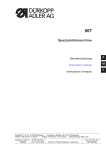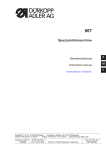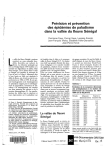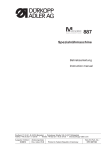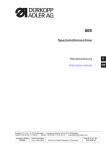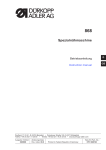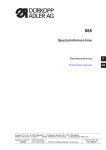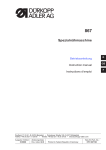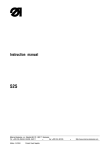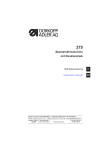Download Adler 767 Instruction manual
Transcript
767 Spezialnähmaschine Betriebsanleitung D Instruction manual GB Manuel d'instructions Postfach 17 03 51, D-33703 Bielefeld • Potsdamer Straße 190, D-33719 Bielefeld Telefon +49 (0) 5 21 / 9 25- 00 • Telefax +49 (0) 5 21 / 9 25 24 35 • www.duerkopp-adler.com Ausg. / Edition: Änderungsindex 10/2008 Rev. index: 03.0 Printed in the Czech Republic Teile-Nr./Part.-No.: 0791 767742 F Alle Rechte vorbehalten. Eigentum der Dürkopp Adler AG und urheberrechtlich geschützt. Jede, auch auszugsweise Wiederverwendung dieser Inhalte ist verboten. All rights reserved. Property of the Dürkopp Adler AG and copyrighted. Reproduction or publication of the content in any manner, without express permission of the publisher, is prohibited. Tous droits réservés. Propriété de la société Dürkopp Adler AG et protégé par la loi sur le droit d’auteur. Une copie ou reproductionpar quelque procédé que ce soit du contenu sans accord écrite de l’auteur est interdite. Copyright ã 2008 - Dürkopp Adler AG Foreword This instruction manual is intended to help the user to become familiar with the machine and take advantage of its application possibilities in accordance with the recommendations. The instruction manual contains important information on how to operate the machine securely, properly and economically. Observation of the instructions eliminates danger, reduces costs for repair and down-times, and increases the reliability and life of the machine. The instruction manual is intended to complement existing national accident prevention and environment protection regulations. The instruction manual must always be available at the machine/sewing unit. The instruction manual must be read and applied by any person that is authorized to work on the machine/sewing unit. This means: – – – Operation, including equipping, troubleshooting during the work cycle, removing of fabric waste, Service (maintenance, inspection, repair) and/or Transport. The user also has to assure that only authorized personnel work on the machine. The user is obliged to check the machine at least once per shift for apparent damages and to immediatly report any changes (including the performance in service), which impair the safety. The user company must ensure that the machine is only operated in perfect working order. Never remove or disable any safety devices. If safety devices need to be removed for equipping, repairing or maintaining, the safety devices must be remounted directly after completion of the maintenance and repair work. Unauthorized modification of the machine rules out liability of the manufacturer for damage resulting from this. Observe all safety and danger recommendations on the machine/unit! The yellow-and-black striped surfaces designate permanend danger areas, eg danger of squashing, cutting, shearing or collision. Besides the recommendations in this instruction manual also observe the general safety and accident prevention regulations! General safety instructions The non-observance of the following safety instructions can cause bodily injuries or damages to the machine. 1. The machine must only be commissioned in full knowledge of the instruction book and operated by persons with appropriate training. 2. Before putting into service also read the safety rules and instructions of the motor supplier. 3. The machine must be used only for the purpose intended. Use of the machine without the safety devices is not permitted. Observe all the relevant safety regulations. 4. When gauge parts are exchanged (e.g. needle, presser foot, needle plate, feed dog and bobbin) when threading, when the workplace is left, and during service work, the machine must be disconnected from the mains by switching off the master switch or disconnecting the mains plug. 5. Daily servicing work must be carried out only by appropriately trained persons. 6. Repairs, conversion and special maintenance work must only be carried out by technicians or persons with appropriate training. 7. For service or repair work on pneumatic systems, disconnect the machine from the compressed air supply system (max. 7-10 bar). Before disconnecting, reduce the pressure of the maintenance unit. Exceptions to this are only adjustments and functions checks made by appropriately trained technicians. 8. Work on the electrical equipment must be carried out only by electricians or appropriately trained persons. 9. Work on parts and systems under electric current is not permitted, except as specified in regulations DIN VDE 0105. 10. Conversion or changes to the machine must be authorized by us and made only in adherence to all safety regulations. 11. For repairs, only replacement parts approved by us must be used. 12. Commissioning of the sewing head is prohibited until such time as the entire sewing unit is found to comply with EC directives. 13. The line cord should be equipped with a country-specific mains plug. This work must be carried out by appropriately trained technicians (see paragraph 8). It is absolutely necessary to respect the safety instructions marked by these signs. Danger of bodily injuries ! Please note also the general safety instructions. Contents Page: Preface und general safety instructions Part 1: Operating manual Cl. 767 (Edition: 10/2008) 1. Product description . . . . . . . . . . . . . . . . . . . . . . . . . . . . . . 5 2. Designated use . . . . . . . . . . . . . . . . . . . . . . . . . . . . . . . . . 5 3. 3.1 Subclasses Optional equipment . . . . . . . . . . . . . . . . . . . . . . . . . . . . . . . 6 4. 4.1 Technical data Subclass technical data . . . . . . . . . . . . . . . . . . . . . . . . . . . . 8 5. 5.1 5.2 5.3 5.4 5.5 5.6 5.7 5.8 5.9 Operation Upper thread . . . . . . . . . . . Adjusting the thread regulator Loser thread . . . . . . . . . . . Changing the needle . . . . . . Lifting sewing feet . . . . . . . Securing the sewing feet . . . . Sewing-foot stroke . . . . . . . Sewing-foot pressure . . . . . . Stitch length . . . . . . . . . . . . . . . . . . . . 10 11 13 15 15 15 17 18 18 6. Keys on sewing arm. . . . . . . . . . . . . . . . . . . . . . . . . . . . . . 19 7. 7.1 7.2 7.3 7.4 7.5 Control and operating panel V810 Operating panel key . . . . . . . . . . . . . V820 Operating panel key . . . . . . . . . . . . . Changing parameter values . . . . . . . . . . . . Direct parameter number selection . . . . . . . . Operator-level parameter list for EFKA controls . . . . . . . . . . . . . . . . . . . . . . . . . . . . . . . . . . . . . . . . . . . . . . . . . . . . . . . . DA82GA and 6F82FA . 21 22 24 24 25 8. Sewing . . . . . . . . . . . . . . . . . . . . . . . . . . . . . . . . . . . . . . 26 9. 9.1 9.2 Maintenance Cleaning and inspection . . . . . . . . . . . . . . . . . . . . . . . . . . . . Lubrication . . . . . . . . . . . . . . . . . . . . . . . . . . . . . . . . . . . . 29 31 . . . . . . . . . . . . . . . . . . . . . . . . . . . . . . . . . . . . . . . . . . . . . . . . . . . . . . . . . . . . . . . . . . . . . . . . . . . . . . . . . . . . . . . . . . . . . . . . . . . . . . . . . . . . . . . . . . . . . . . . . . . . . . . . . . . . . . . . . . . . . . . . . . . . . . . . . . . . . . . . . . . . . . . . . . . . . . . . . . . . . . . . . . . . . . . . . . . . . . . . . . . . . . . GB Contents Page: 10. 10.1 10.2 10.3 10.4 10.5 10.6 10.7 Optional equipment Residual-thread monitor RFW 13-3/RFW 13-6/RFW 13-8/RFW 13-9 2nd Stitch length STLS 13 - 2 . . . . . . . . . . . . . . . . . . . . . . . Electro-pneumatic rapid stroke adjustment HP 13 - 7 . . . . . . . . . Upper and lower conveyor rollers SP 470 . . . . . . . . . . . . . . . . Automatic lowering WTA 13 - 2 . . . . . . . . . . . . . . . . . . . . . . . Additional tension FS 13 - 1 . . . . . . . . . . . . . . . . . . . . . . . . . Seam center guide . . . . . . . . . . . . . . . . . . . . . . . . . . . . . . . . . . . . . 32 34 36 37 38 39 41 11. 11.1 11.2 11.3 11.4 11.5 Short thread trimmer Check EPROM-Version . . . . . . . . . . . . . . . . . . . . Position of the thread-pulling knife and the counter-knife Adjust the thread cutting stitch before thread cutting . . . Thread clamp (Thread feeding device) . . . . . . . . . . . Errors, Cause and Remedy . . . . . . . . . . . . . . . . . . . . . . . 43 43 43 44 44 . . . . . . . . . . . . . . . . . . . . . . . . . . . . . . . . . . . The illustrations in this operating manual relate to various subclasses of the special sewing machine ! Please bear in mind that your special sewing machine may be different from the machine illustrated ! 1. Product description The DÜRKOPP ADLER 767 is a special sewing machine with universal applications. · · Flat-bed double-stitch sewing machine with lower conveyor, needle transport and alternating upper foot conveyor. Subclasses available: one or two needles, with or without edge cutter and with or without thread trimmer beneath the stitch plate. Single-needle machines are convertible to double-needle machines. (not 767-AE-73 / 767-AE-5-73) · All subclasses have device racks in the base plate for the rapid replacement of various devices. (not 767-AE-73 / 767-AE-5-73) · Maximum clearance beneath lifted sewing feet: 16 mm (with -AE and -LG max. 13 mm). · · · · · 2. Stroke of alternating sewing feet adjustable with adjusting wheel by up to 7 mm. Automatic non-pressurised oil-circulating lubrication with sight glasses for oil level and oil circulation. Integrated hook lubrication. Large, two-piece vertical hook with spool-housing lifting device. Oversized, two-piece vertical hook with spool-housing lifting device. A safety coupling prevents the hook from being displaced or damaged if the thread jams in the hook track. Designated use The designated use of the 767 sewing machine is sewing light to medium-heavy materials. Such material is generally made of textile fibres, but it may also be leather. It is used in the clothing industry and for domestic and motor-vehicle upholstery. This sewing machine can also be used to produce so-called technical seams. In this case, however, the operator must assess the possible dangers which may arise (with which DÜRKOPP ADLER AG would be happy to assist), since such applications are on the one hand relatively unusual and, on the other, they are so varied that no single set of criteria can cover them all. The outcome of this assessment may require appropriate safety measures to be taken. Generally only dry material may be sewn with this machine. The material may be no thicker than 10 mm when compressed by the lowered sewing feet. The material may not contain any hard objects, since if it does the machine may not be operated without an eye-protection device. No such device is currently available. The seam is generally produced with textile-fibre sewing thread of gauge 11/3 Ne (cotton), 11/3 Nm (synthetic) or 11/4 Nm (covering yarn). Before using any other thread the possible dangers arising must be assessed and appropriate safety measures taken if necessary. This sewing machine may be set up and operated only in dry, well-maintained premises. If the sewing machine is used in other premises which are not dry and well-maintained it may be necessary to take further precautions (which should be agreed in advance - see EN 60204-31: 1999). As manufacturers of industrial machinery we proceed on the assumption that personnel who work on our products will have received training at least sufficient to acquaint them with all normal operations and with any hazards which these may involve. B 5 GB 3. Subclasses The following table lists the features of the various subclasses. Subclass - 73 AE - 73 AE - 5 - 73 FA - 73 LG - 73 FA - 273 FA S - 473 ***) 373 FA - 373 *) KFA - 373 **) KFA - 573 ****) FAS - 373 ***) FAS - 573 ***) VF - 373 VF - 573 Legend: 3.1 Material DoubleNeedle M M M M M M M M M M M M M M M x x - Hook Left x x x x x Thread Trimmer Edge Cutter x x x x x x x x x x x x x x Edger x x x - M = medium-heavy material / x = standard / - = not available Optional equipment The following optional equipment can be supplied for the 767: RAP 13-2 *) Electro-pneumatic stitch locking and sewing-foot lift, pedal-operated. RAP 13-4 Electro-pneumatic stitch locking and sewing-foot lift, pedal-operated. RAP 13-6 **) Electro-pneumatic stitch locking and sewing-foot lift, pedal-operated. RAP 13-6 ****) Electro-pneumatic stitch locking and sewing-foot lift, pedal-operated. RAP 13-7 ***) Electro-pneumatic stitch locking and sewing-foot lift, pedal-operated. FLP 13-2 Electro-pneumatic sewing-foot lift, pedal-operated. NK 13-1 Pneumatic needle cooling, pedal-operated. NP 13-4 Electro-pneumatic needle-retraction device for maximum clearance beneath sewing feet when lifted. HP 13-7****) Electro-pneumatic rapid stroke adjustment by knee switch. SP 470 Roller feed device, with adjustable upper and lower conveyor rollers. WTA 13-2 Automatic lowering for upper conveyor roller. LR 13-4 Light barrier for automatic triggering of RAP at end of thread. KNS 2 Knee switch for triggering manual reverse sewing. WE 3 Maintenance unit. WE 6 Maintenance unit for pneumatic optional equipment. RFW 13-3 Residual-thread monitor bobbin thread. RFW 13-8 Residual-thread monitor bobbin thread (KFA). RFW 13-9 Residual-thread monitor bobbin thread (oversized hook). STLS 13-2 2nd Stitch length. FS 13-1 Additional tension. N800 005611 Seam center guide. *) **) ***) ****) = Integrated for the subclasses 6 4. Technical data Rated voltage: 3 ~ 400 V, 50 Hz 1 ~ 230 V, 50/60 Hz Dimensions: Weight: Working height: (H x W x D) approx. 56 kg 790 mm Noise: work-place-related emission value in accordance with DIN 45635-48-A-1-KL2 767 - FA - 373 - 373 Lc = 83 dB (A) 1570 x 500 x 1050 mm (machine head only) (ex works) -1 stitch length: 5 mm sewing-foot stroke: 1.5 mm stitch rate: 3 000 min material: G1 DIN 23328 4-layer 767 - FA - 373 - 373 Lc = 83 dB (A) stitch length: 7.2 mm sewing-foot stroke: 5.6 mm stitch rate: 2 000min -1 2 material: 2-ply Skai 1.6 mm 900 g/m DIN 53352 767 - FAS - 473 767 - FA - 273 - 273 Lc = 85 dB (A) 767 - FAS - 473 767 - FA - 273 - 273 Lc = 84 dB (A) -1 stitch length: 6 mm sewing-foot stroke: 5.6 mm stitch rate: 2 000 min needle distance: 8 mm 2 material: 2-ply Skai 1.6 mm 900 g/m DIN 53352 767 - LG - 73 Lc = 83 dB (A) stitch length: 5 mm sewing-foot stroke: 1.6 mm stitch rate: 2 700 min -1 needle distance: 8 mm material: G1 DIN 23328 3-layer stitch length: 6 mm sewing-foot stroke: 3.5 mm stitch rate: 2 800 min- material: upholstery fabric faced both sides 435 g/m 767 - VF - 573 767 - VF - 373 Lc = 85 dB (A) stitch length: 6 mm sewing-foot stroke: 3.5 mm stitch rate: 2 800 min material: upholstery fabric faced both sides 435 g/m 767 - AE - 5 - 73 767 - AE - 73 767 - FAS - 373 -1 2 Lc = 84 dB (A) stitch length: 6 mm sewing-foot stroke: 3.5 mm stitch rate: 2 800 min material: upholstery fabric faced both sides 435 g/m 1 2 -1 2 Lc = 83 dB (A) stitch length: 5 mm sewing-foot stroke: 1.5mm stitch rate: 3 000 min -1 material: G1 DIN 23328 4-layer 767 - FAS - 373 Lc = 83 dB (A) stitch length: 7.2mm sewing-foot stroke: 5.6mm stitch rate: 2 000min -1 2 material: 2-ply Skai 1.6 mm 900 g/m DIN 53352 767 - FAS - 573 Lc = 83 dB (A) stitch length: 5 mm sewing-foot stroke: 1.6 mm stitch rate: 2 500 min -1 material: G1 DIN 23328 4-layer 767 - FAS - 573 Lc = 80 dB (A) stitch length: 7.2mm sewing-foot stroke: 5.6mm stitch rate: 1500 min -1 2 material: 2-ply Skai 1.6 mm 900 g/m DIN 53352 767 - KFA - 373 - 573 Lc = 83 dB (A) stitch length: 5 mm sewing-foot stroke: 1.6 mm stitch rate: 2 500 min -1 material: G1 DIN 23328 4-layer 767 - KFA - 373 - 573 Lc = 80 dB (A) stitch length: 7.2mm sewing-foot stroke: 5.6mm/ stitch rate: 1 500 min -1 2 material: 2-ply Skai 1.6 mm 900 g/m DIN 53352 7 GB 4.1 Subclass technical data Subclass 767 -73 -373 -FA- 73 -FA-373 -FAS-473 -FA-273 -273 -LG-73 stitch rate: - max. - ex works [min -1 ] [min ] -1 3200 3200 3500 3200 3200 3200 3500 3200 3200 3000 stitch length: - forwards - backwards [mm] [mm] 9 9 9 9 9 9 9 9 9 9 stroke height of alternating sewing feet: - max. [mm] - ex works [mm] 7 1-6 7 1-6 7 1-6 7 1-6 7 1-6 134-35 134-35 134-35 134-35 134-35 110-140 110-140 90-110 110-140 90-110 110-140 110-140 110-140 24 / 3 24 / 3 24 / 3 24 / 3 24 / 3 30 / 3 30 / 3 30 / 3 30 / 3 30 / 3 30 / 3 30 / 3 30 / 3 30 / 3 30 / 3 35 35 56 35 35 - - 4-30 4 - 36 - 10 16 10 9 (16) 10 9 (16) 10 9 (16) 10 13 80 80 80 80 80 6 6 6 6 6 0,7 0,7 0,7 0,7 0,7 needle system: needle thickness: (depending on E no.) sewing-thread thicknesses: a) cotton [NeB] b) synthetic sewing yarn [Nm] c) covering yarn [Nm] max. spool capacity with synthetic yarn ca. [m] needle width/needle distance (depending on sewing device and E no.) [mm] max. clearance beneath sewing feet: - sewing [mm] - lifted [mm] handwheel belt groove central Ø [mm] operating pressure [bar] air consumption 8 [NL] Subclass -VF-573 -VF-373 stitch rate: - max. - ex works [min -1 ] [min ] stitch length: - forwards - backwards -1 -AE-5-73 -KFA-373 -FAS-373 -FAS-573 -AE-73 -573 3000 2800 2800 2800 3500 3200 3500 3200 3200 3200 [mm] [mm] 9 9 9 9 9 9 9 9 9 9 stroke height of alternating sewing feet: - max. [mm] - ex works [mm] 7 1-6 7 1,6 - 7 7 1,5 - 6 7 1-6 7 1-6 134-35 134-35 134-35 134-35 134 - 35 110-140 110-140 110-140 110-140 110-140 24 / 3 24 / 3 24 / 3 24 / 3 24 / 3 30 / 3 30 / 3 30 / 3 30 / 3 30 / 3 30 / 3 30 / 3 30 / 3 30 / 3 30 / 3 35 35 35 35 56 - - - - - 10 9 (16) 10 13 10 9 (15) 10 9 (16) 10 9 (16) 80 80 80 80 80 6 6 6 6 6 0,7 0,7 0,7 0,7 0,7 needle system: needle thickness: [Nm] (depending on E no.) thread thicknesses: a) cotton [NeB] b) synthetic sewing yarn [Nm] c) covering yarn [Nm] max. spool capacity with synthetic yarn ca. [m] needle width/needle distance (depending on sewing device and E no.) [mm] max. clearance beneath sewing feet: - sewing [mm] - lifted [mm] GB handwheel belt groove central Ø [mm] operating pressure [bar] air consumption [NL] 9 1 14 15 - 2 3 4 + 7 8 9 10 11 12 5 6 13 5. Operation 5.1 Upper thread Caution! Danger of injury! Turn off main switch! The upper thread may only be threaded with the sewing machine switched off. Threading upper thread (needle thread) – Place the thread spool on its column and pass the thread through the guide eyelets of the take-up arm. – Pass the thread through guide 7 and anti-clockwise round pre-tensioner 8. Pass thread once more through guide 7. – Pass the thread round guide 11 and anti-clockwise round main tensioner 10. Pass the thread clockwise round main tensioner 12. 10 – Pass the thread clockwise round tension unit 4, past thread-tensioning spring 3 and through guide 2. – – Pass the thread through thread lever 1 and through guides 2, 5 and 6. Pass the thread through the needle, pull a few centimetres of thread through and cut it off. Threading the upper thread (2-needle machines) Sewing machines with 2 needles are threaded similarly to single-needle machines. The differences can be seen in the illustration. The thread-tensioning unit 13 is a double unit and can thus be used on both 1 and 2-needle machines. Adjusting the upper-thread tensioner Tension should be as low as possible. The cross-over point should be in the centre of the material. – Adjusting the pre-tensioner 8. The pre-tension should be set lower than the main tension. – Adjusting main tensioner (10 and 12). Raising the upper-thread tensioner The upper-thread tensioner is automatically raised when the thread is severed. – Press knob 9. Die upper-thread tensioner remains in the raised position for as long as the knob is held down. GB 5.2 Adjusting the thread regulator The thread regulator 14 regulates the amount of needle thread necessary for stitch formation. The setting depends on the following factors: - material thickness - yarn characteristics - stitch length A properly-adjusted thread regulator ensures an ideal sewing result at a minimum needle-thread tension. At the correct setting the needle-thread loop must slide at low tension over the thickest point of the shuttle. Caution - danger of injury! Turn off the main switch. The thread regulator may only be adjusted with the sewing machine switched off. – – Undo both screws 15. – Tighten screws 15. Move the thread regulator 14. The thread regulator is fitted with slots for this purpose. Moving in the “+” direction increases the quantity of needle thread. Moving in the “-” direction reduces the quantity of needle thread. 11 1 2 3 4 5 6 7 8 12 9 10 11 5.3 Lower thread Look out! Danger of injury! Turn off main switch! The lower thread may only be threaded with the sewing machine switched off. Threading the lower thread (hook thread) – – Place the thread spool on its column. – Pass the thread anti-clockwise round tensioner 1 and once more through the thread guide. – Carefully wind a few turns of thread anti-clockwise onto the spool by hand and place the spool on its column. – Swivel the bobbin winder 4 against the empty spool. The thread is wound onto the spool during sewing. When spool 3 is full, winding-on is halted by the bobbin-winder lever 4. – Adjusting tension 1. The thread should be wound on at minimum tension. Pass the lower thread through the thread guide on the take-up arm and alternately through the guide of the pre-tensioner 1. GB Threading the lower thread – – Raise flap 5 and remove the empty spool with a magnet or tweezers. – – – Pass the thread through slit 7 and below spring 10. Insert spool 6 in such a way that when the thread is unwound from it moves in the opposite direction to the hook. Pass the thread through slit 8 and pull about 3 cm through. Close flap 5 and pass the thread through the flap’s guide 9. Adjusting the lower-thread tension The lower-thread tension should be set in accordance with the type of seam required. Adjust the tension with screw 11. Fig. a: correct thread interlacing in the centre of the material Fig. b: needle-thread tension too low or looper-thread tension too great Fig. c: needle-thread tension too great or looper-thread tension too low 13 1 2 3 14 5.4 Changing the needle Look out! Danger of injury! Turn off main switch! The needle may only be threaded with the sewing machine switched off. – – – – Turn the handwheel until the needle bar has reached its uppermost position. – Tighten screw 1. Undo screw 1. Remove needle. Insert the new needle with its throat towards the hook and push it up as far as it will go. IMPORTANT ! If a needle of a different thickness is fitted the settings must be altered as specified in the service manual. Otherwise a thinner needle may cause missed stitches or damage to the thread, while a thicker needle may damage the tip of the hook or the needle itself. GB 5.5 Lifting sewing feet Depending on the machine version the sewing feet can be raised mechanically or pneumatically. Mechanical – Operate knee lever 2. Pneumatic (FLP or RAP required) – 5.6 Pull pedal half-way back. Securing the sewing feet Once they have been raised, either mechanically or pneumatically, the sewing feet can be secured in the raised position with lever 3. – Swivel lever 3 downwards. The sewing feet are secured in the raised position. – Swivel lever 3 upwards. They are now released. 15 1 2 16 5.7 Sewing-foot stroke The height of the sewing-foot stroke is set with adjusting wheel 1. Machines without FA (without Thread Trimmer) On these machines the speed of rotation is not checked. Please comply with the note and table below. Machines with FA (with Thread Trimmer) The sewing-foot stroke and stitch rate are interdependent. A potentiometer is linked mechanically with the adjusting wheel 1. By means of this potentiometer the control unit detects which foot-stroke has been set and restricts the speed accordingly. Machines with HP 13 - 7 (Speedomat) The maximum stroke can be activated while sewing is in progress with the knee switch 2. Like machines with FA, these machines also have a potentiometer. Adjusting the sewing-foot stroke – Set adjusting wheel 1. Min. , A , B , C , D , E , F , max. min. = minimum stroke max. = maximum stroke NOTE In order to ensure maximum durability and safety in operation, the maximum stitch rates given in the table below should not be exceeded. Stitch-length range Adjusting mm wheel item (mm foot stroke) 0-6 6-9 1) Subclass Max. stitch rate stitches/min - 373 / - 273 -VF-373 / VF-573 -AE-73 / AE-5-73 -FAS-473 -FAS-573 -all others 3 3 2 3 3 3 C-D (2 - 5 mm) -VF-373 / VF-573 -AE 73 / VF-5-73 -all others 2 500 2 300 2 700 (3 000) E - max (5 - 7 mm) all 2 000 min - max (1 - 7 mm) all 2 000 min. - B (up to 2 mm) 000 000 800 200 200 200 (3 500) 1) 1) On machines with the speedomat HP 13 - 7 the stitch rate may be increased by about 300 stitches/min to the figures in brackets. The HP 13 - 7 is described in detail on page 36. 17 GB 5.8 Sewing-foot pressure 1 4 2 3 5 The required sewing-foot pressure is set with rotary knob 1. – 5.9 to increase sewing-foot pressure = turn knob 1 clockwise to decrease sewing-foot pressure = turn knob 1 anti-clockwise. Stitch length The required stitch length is set with rotary knob 2. – to increase stitch length = turn knob 2 clockwise to decrease stitch length = turn knob 2 anti-clockwise. 5.9.1 2nd Stitch length The following subclasses are equipped with the 2nd stitch length: 767-FAS-373-RAP-HP, 767-FAS-573-RAP-HP, 767-KFA-373-RAP-HP, 767-KFA-573-RAP-HP, 767-FAS-473-RAP-HP. Thus it is possible to activate the 2nd stitch length through one switch. Use the setting wheels 3 and 5 to set both stitch length. – – Set the longer stitch length with the upper setting wheel 3. Set the shorter stitch length with the lower setting wheel 5. Altering the shorter stitch length will be easier if the longer stitch length is activated (LED 7 on) beforehand. Attention ! The stitch length adjusted at the lower setting wheel 5 must never be greater than that adjusted at the upper setting wheel 3. – 18 With the switch 4 you can change over from one stitch length to the other. When the LED 7 is on, the longer stitch length is active. When the LED 3 is off, the shorter stitch length is active. 6. Keys on sewing arm 5 5 1 Key key 1 key 2 key 3 key 4 = = = = LED LED 5 = LED 6 = LED 7 = 2 3 6 6 (7) 7 4 1 2 3 (4) Function Intermediate lock-stitches during sewing Raises or lowers needle Suppress starting or finishing lock-stitches Stitch length GB Display Sewing motor switched on Lock-stitches suppression switched on Stitch length – Press and hold down key 1. Intermediate lock-stitches are sewn. The machine sews backwards for as long as the key is held down. – Press key 2. The needle is raised or lowered. – Press key 3. The next starting or finishing lock-stitches are not sewn. – Press key 4. The 2nd stitch length is activated. If the 2nd stitch length has already been activated then pressing key 4 reactivates the 1st stitch length. 19 7. Control unit and operating panel IMPORTANT ! This manual covers only those key functions and parameter changes available to the operator. For a more detailed description of the control unit please consult the motor manufacturer’s current Operating manual (supplied). The operating panel is used to program the control unit and to set seam functions. Depending on the nature of the job, sewing may be executed manually or by seam programming. For various sewing tasks seams can be programmed for which the functions (starting and finishing lock-stitches, stitch counting etc.) and parameter values (number of stitches, seam length, speed of rotation etc.). Entry is carried out in programming mode. The parameters and the values assigned are displayed. The seam programs are not lost even if the sewing machine is switched off (battery buffer). In order to avoid the inadvertent alteration of pre-set functions operation is divided into several levels (operator, technician, fitter). The operator (seamstress) can program it directly. On the other levels access is contingent on the entry of a code number. RESET If the control unit is hopelessly misadjusted, this function allows the technician to reset all adjusted values to their default (ex-works) setting. This function is described in the Installation Instructions. 20 7.1 V810 Operating Panel Keys C D 1 E 2 3 F 4 G A B Key Function P Start or end programming mode E Confirm a parameter-value change + Increase a displayed parameter value - Decrease a displayed parameter value 1 Starting bar tack or starting stitch condensation SINGLE / DOUBLE / OFF 2 Ending bar tack or ending stitch condensation SINGLE / DOUBLE / OFF 3 Auto foot lift on stop in mid-seam ON / OFF 3 Auto foot lift after thread trimming ON / OFF 4*** Basic needle position (UT/OT) POSITION 1 / POSITION 2 A* Key for bar tack suppression or activation B** Key for needle up/down or shift-key in programming mode Symbol C D E F Settings GB Function Automatic rotation speed active Light barrier switched on Machine running Limited rotation speed active * Other functions possible (see parameter 293) ** Other functions possible (see parameters 294) *** Other functions possible (see parameters 291) e.g. “A” key parameter F-293-18 “B” key parameter F-294-18 21 7.2 V820 Operating Panel Keys Key Function Settings P Start or end programming mode E Confirm a parameter-value change + Increase a displayed parameter value - Decrease a displayed parameter value 1 Starting bar tack or starting stitch condensation single / double / off 2 Seam stitch counting forward / reverse / off 3 Light barrier function bright-dark / dark-bright/ off 3 Auto foot lift after thread trimming on / off 4 Ending bartack single / double / off or ending stitch condensation 5 Thread cutter/thread wiper thread cutter/thread cutter and thread wiper / off 6 Auto foot lift on stop in mid-seam Auto foot lift after thread trimming on / off on / off 7 Basic needle position position 1 / position 2 8 Bobbin thread monitor on / off 9 Key function programmable 0 Teach in / sew stored sewing program 22 Symbol Functions A* Key for bar tack suppression or activation B** Key for needle up/down or shift-key in programming mode C Abbreviation C for the code number D Abbreviation F for the parameter number E Program number in teach-in mode F Seam-section number in teach-in mode G Cut-out active H Entry via keys disabled I Error message J Stitch-rate entry in teach-in mode K Bobbin-thread monitor on. Symbol flashes when the bobbin is running out L Speed limit effective M Right needle switched off O Machine running P Automatic speed effective Q Left needle switched off GB 23 7.3 Changing parameter values CAUTION! After changing parameters it is essential to carry out a sewing run. Only then is the altered setting properly saved. If sewing does not take place, the new setting is lost when the main switch is turned off. Parameters are changed and switched on and off with the “P”, “E”, “+” and “-” keys on the operating panel. The parameters which can be changed at operator level are listed below. 1. 2. – 3. Switch on mains. Start programming mode Press the “P” key. The last parameter to have been called appears. If no parameter has been called since the main switch was turned on, “F - 000” appears in the display. Select required parameter – Press the “+” or “-” key repeatedly until the required parameter appears in the display. If the “+” or “-” key is held down, the parameter number automatically cycles until the key is released. – Pressing the “E” key displays the parameter value. 4. – 5. – Change displayed parameters Press the “+” or “-” keys to change the value of the parameter or switch its function on and off. Save change parameter values Press the “E” key to change further parameter values. The changed parameter value is saved. The next operator-level parameter appears in the display. or: – Press the “P” key to leave programming mode. The last parameter value to have been changed is saved. The control system leaves programming mode. – Commencing sewing saves the new values, which are thus preserved when the machine is switched off. 7.4 Direct parameter number selection The parameter number can also be selected directly: – When a parameter number is displayed, press the “>>” key. The first character flashes. – Move to the next character by pressing the “+” or “-” keys. 24 7.5 Operator-level parameter list for EFKA controls DA82GA and 6F82FA Parameter No. Abbr. 000 001 002 003 004 Arv Arr Err Erv LS 005 LSF 006 LSn 007 Stc 008 F 009 010 LS cLS 013 014 015 080 FA FW StS SAv 081 SAr 082 SEr 083 SEv 085 cFW Name/Function Adj. Range min max starting-bar-tack stitches forward 0 254 starting-bar-tack stitches backward 0 254 ending-bar-tack stitches backwards 0 254 ending-bar-tack stitches forwards 0 254 number of light-barrier equalisation 0 254 stitches (large stitch length) number of light-barrier filter stitches 0 254 for knits number of seams terminated with 0 15 the light barrier number of stitches in the 0 254 automatically-produced seam section assigning a function to key 9 1 5 1 = softstart ON/OFF 2 = ornamental-stitch bar tack ON/OFF 3 = stroke adjustment press and release = ON / press and hold = OFF 4 = needle cooling ON/OFF 5 = handwheel reverse ON/OFF ** light barrier ON/OFF OFF ON number of light-barrier 0 254 equalising stitches (small stitch length) thread cutter ON/OFF OFF ON thread retractor ON/OFF OFF ON stitch count ON/OFF OFF ON number of stitches, starting 0 254 decorative-stitch bar tack forwards number of stitches, starting 0 254 decorative-stitch bar tack backwards number of stitches, ending 0 254 decorative-stitch bar tack backwards number of stitches, ending 0 254 decorative-stitch bar tack forwards residual-thread-monitor stitch count F-195 = 1-3 0 2540 F-195 = 4 0 9990 Preset 100R 2 4 3 3 4 0 1 10 2 OFF 8 GB ON ON ON 3 3 3 3 0 0 25 8. Sewing This description is based on the following assumptions: – The machine is a single-needle machine fitted with the following optional equipment: - FA Thread Trimmer - RAP Electro-pneumatic seam-locking and sewing-foot lift, pedal-operated - FLP Electro-pneumatic sewing-foot lift, pedal-operated - HP Electro-pneumatic rapid stroke adjustment – The following functions are set at the operating panel: - starting or finishing lock-stitch : ON - sewing-foot position before and after cutting: DOWN - needle position before cutting: DOWN (1st position) - needle position after cutting: UP (turn-back after starting 2nd position) – – Main switch on. The last sewing process was completed with finishing lock-stitch and thread cutter. Operating and function sequence 1 2 Sewing process 3 4 1 2 3 (4) Operation / Explanation Prior to sewing Starting position - Pedal in rest position The machine is at a halt. Needle up, sewing feet down. Position material correctly for starting the seam. - Press key 2. The needle is fully lowered. - Push pedal half-way back. The sewing feet are raised. - Push material forward until it touches the needle. Continued on next page ! 26 1 2 3 Sewing process 4 1 2 3 (4) Operation/explanation At start of seam Sew starting lock-stitch and continue - Push pedal forwards and hold it there. The starting lock-stitch is sewn. Sewing then continues at the speed of rotation determined by the pedal. Sew only starting lock-stitch - Push pedal forwards briefly. The machine halts in the 1st position after the starting lock-stitch. Do not sew starting lock-stitch - Press key 3, then push pedal forwards. The machine begins sewing at the speed of rotation determined by the pedal. In mid-seam Interrupt the sewing process GB - Release pedal (rest position). The machine halts in the 1st position. The sewing feet are down. Sew a corner - Pull pedal half-way back. The machine halts in the 1st position. The sewing feet are up. - Rotate the material about the needle. Resume the sewing process (after releasing the pedal) - Push pedal forwards. The machine sews at the speed of rotation set by the pedal (no starting lock-stitch is sewn). Sew an intermediate lock-stitch - Press key 1 and continue to hold the pedal forwards. The machine sews backwards for as long as key 1 is held down. The speed of rotation is determined by the pedal. Continued on next page ! 27 Sewing process Transfer-seam over-sewing - Operate knee switch. The speed of rotation is restricted to 2 000 stitches/min. At the end of the seam - Pull pedal fully back and hold it there. The finishing lock-stitch is sewn. The thread is cut off. The machine halts in the 2nd position. The needle is up (turn-back ). The sewing feet are up. Remove material 28 Operation / Explanation Do not raise sewing feet - Briefly pull pedal fully back. The finishing lock-stitch is sewn. The thread is cut off. The machine halts in the 2nd position. The needle is up (turn-back). The sewing feet are down. Do not sew a finishing lock-stitch - Pres key 3 and pull pedal fully back. The finishing lock-stitch is not sewn. The thread is cut off. The machine halts in the 2nd position. The needle is up (turn-back). The sewing feet are up or down depending on the pedal position. 9. Maintenance Caution! Danger of injury! Turn off main switch! Maintenance may only be carried out with the sewing machine switched off. Maintenance work must be carried out no less frequently than at the intervals given in the tables (see “operating hours” column). Maintenance intervals may need to be shorter when processing heavy-shedding materials. 9.1 Cleaning and inspection A clean sewing machine is a protection against malfunctions. 2 GB 1 3 4 5 6 29 Maintenance work to be carried out Explanation Upper part of machine Places in special need of cleaning: - area under the needle plate 1 - feeders - area around the shuttle 2 - upper part of bobbin housing 3 - inner surface of shuttle cover - needle-thread tensioners 8 - Clean oil collector. - Remove lint and oil spills with a cloth 8 - Check the function of the safety clutch. - See service instructions chapter 10 500 It must be possible to depress the V-belt by about 10 mm by pressing it with a finger at its mid-point. 160 The water level must not rise as high as the filter insert 4. - After screwing in the drain screw 6 blast water under pressure out of the water separator 5. 40 - Remove lint, pieces of thread and other cutting waste. Operating hours Sewing drive - Check the condition and tension of the V-belt. Compressed-air maintenance unit (optional equipment) - Check the water level in the pressure regulator. NB: The water separator 5 is fitted with semi-automatic condensation drainage. When the pressure falls below a certain level the condensation is automatically drained. Clean the filter insert. 30 Dirt and condensation are separated out by the filter insert 4. - Disconnect the machine from the compressed-air supply. - Screw in drain screw 6. There must be no pressure in the machine’s pneumatic system. - Unscrew water separator 5. - Unscrew filter insert 4 Wash the filter shell and insert with cleaning fluid (not solvent!) and blast clean. - Re-assemble and connect the maintenance unit. 500 9.2 Lubrication 1 2 1 (until July 2003) (from August 2003) Check the oil level at the sight glass 2 every week. GB Top up the oil reservoir only with DA-10 oil or an equivalent oil with the following specification: – – 2 Viscosity at 40° C : 10 mm /s Ignition point: 150 °C DA-10 can be obtained from DÜRKOPP ADLER AG sales outlets. The part numbers are: 250 ml - Container: 1 litre - Container: 2 litre - Container: 5 litre - Container: 9047 9047 9047 9047 000011 000012 000013 000014 – – Remove oil-filling screw 1 and pour in oil. – Replace oil-filling screw 1. Clean up any oil overflow. Check oil level at sight glass 2. The oil level must be between “EMPTY” and “FULL”. 31 10. Optional equipment 10.1 Residual-thread monitor RFW 13-3/RFW 13-6/RFW 13-8/RFW 13-9 1 The residual-thread monitor monitors the amount of thread in the shuttle bobbin. An acoustic signal is sounded when only a small amount of thread is left. The operative can finish the seam and fit a new spool. This avoids material damage and thus any need for repairs. The residual-thread monitor RFW 13-3, part no.: 0767 367629, can be fitted to all single-needle 767 sewing machines with a thread cutter. The residual-thread monitor RFW 13-6, part no.: 0767 590244, can be fitted to the class 767-KFA-573-RAP/HP (short thread trimmer). The residual-thread monitor RFW 13-8, part no.: 0767 590194, can be fitted to the class 767-KFA-373 (short thread trimmer). The residual-thread monitor RFW 13-9, part no.: 0767 590234, can be fitted to the class 767-FAS-473 / 767-VF-573 (oversized hook). Function and operation of the residual-thread monitor If the light beam from the light barrier is reflected by the surface 3 of the spool, the sewing process is interrupted. An acoustic signal sounds for 2 seconds. – Release the pedal and then push it forwards again. The seam is continued. The amount of thread in the supply groove 4 of the shuttle bobbin is usually sufficient to complete it. – At the end of the seam pull the pedal back. The thread is cut off. The acoustic signal sounds for a further 2 seconds to remind the operator to change the spools. 32 Caution! Danger of injury! Turn off main switch! The shuttle bobbin must not be changed unless the machine is switched off. – Change the bobbin. A new seam can now be sewn. IMPORTANT ! The bobbin must be put in place with the groove 2 facing downwards. The area of the spool housing and the light barrier must be kept free of dust. If the empty bobbin is not replaced by a full one, the acoustic signal sounds again when the next seam is sewn. Depending on the setting: - Either the signal sounds continuously all the time the seam is being sewn until the thread is cut - or it sounds for 2 seconds the next time the thread is cut. – Winding on spool thread. The procedure is described in this operating manual. GB IMPORTANT ! The groove 2 must face upwards for winding on. Wind the thread round the spool manually only in the area of the supply groove 4. 2 3 4 33 10.2 2nd stitch length STLS 13 - 2 2 1 3 4 The facility to activate a 2nd stitch length makes it possible to switch rapidly from the assembly seam to the subsequent overstep seam. The 1st or 2nd stitch length is selected with the keys on the sewing arm. The 2nd stitch length is always smaller than the 1st. The 2nd stitch length is active when the machine is switched on. Function and operation 1 2 3 4 34 Name Function Rotary knob Scale Knurled screw Scale Adjusts 1st stitch length 2nd stitch length is displayed Adjusts 2nd stitch length 1st stitch length is displayed 10.2.1 Integrated second stitch length The subclasses 767-FAS-373-RAP-HP, 767-FAS-573-RAP-HP, 767-KFA-373-RAP-HP, 767-KFA-573-RAP-HP, 767-FAS-473-RAP-HP are equipped with a second stitch length. Herewith it is possible to activate a shorter second stitch length just via a switch. 1 2 3 4 Both stitch lengths are defined by means of the two setting wheels 1 and 2. – – Set the longer stitch length with the upper setting wheel. – With the switch 4 you can change over from one stitch length to the other. When the light emitting diode 3 is shining, the longer stitch length is active. When the light emitting diode 3 does not shine, the shorter stitch length is active. Set the shorter stitch length with the lower setting wheel. GB ATTENTION ! The stitch length adjusted at the lower setting wheel must never be longer than that adjusted at the upper setting wheel. 35 10.3 Electro-pneumatic rapid stroke adjustment HP 13 - 7 1 2 The sewing-foot stroke and stitch rate are interdependent. A potentiometer is linked mechanically with the adjusting wheel. By means of this potentiometer the control unit detects what foot-stroke has been set and restricts the speed of rotation accordingly. The values are given in the table on page 17. The maximum stroke can be activated while sewing is in progress with the knee switch 2. Caution! Danger of injury! Turn off main switch! Adjust the sewing-foot stroke only with the machine switched off. Operation mode of the quick stroke adjustment The activation period of the maximum sewing foot stroke depends on the set operation mode. It is possible to choose between three operation modes. The individual operation modes are determined by the adjustment of the parameters F-138 and F-184 at the control panel (see enclosed instructions of the motor manufacturer). Operation mode Operation / Explanation Keystroke mode F-138 = off F-184 = 0 The maximum sewing foot stroke remains engaged as long as the knee switch 2 is actuated. Push-lock mode F-138 = on The maximum sewing foot stroke is engaged by actuating the knee switch 2. By actuating the knee switch once again the maximum sewing foot stroke is disengaged. Keystroke mode with min. speed F-138 = off F-184 > 0 The maximum sewing foot stroke remains engaged as long as knee switch 2 is actuated. After releasing the knee switch the machine sews with maximum sewing foot stroke until the set minimum speed is reached (parameter F-184). Then the seam is continued with normal sewing foot stroke. 36 10.4 Upper and lower conveyor rollers SP 470 1 2 3 The removal of the material by the upper and lower conveyor rollers after sewing ensures a smooth and uniform product. The speed with which the material is removed can be exactly matched to the stitch length. The pressure can be set at a level appropriate to the material. GB – Lever 1 Matches the speed of the upper and lower conveyor rollers to the stitch length set. – Screw 2 Adjusts the upper conveyor-roller pressure to the material being processed. – Lever 3 Lowers the upper conveyor roller. 37 10.5 Automatic lowering WTA 13 - 2 This is an optional item to go with the upper and lower conveyor rollers. It enables the stitches to be adjusted from the beginning of the seam to the automatic lowering of the upper roller. This ensures that the roller is not lowered until the material is beneath it. Manual operation Parameter F-186 = 0 Automatic operation Parameter F-186 > 0 F-260 = ON or OFF F-261= 0 F-261 = 1 F-261 F-261 F-262 F-262 = 1 38 Function Lowering or lifting the feed roller through actuating the button. Function Automatic lowering of the roller after a number of stitches have been set Stitch delay after sewing foot lowering until roller lowering in the seam OFF = Stitch delay Off ON = Stitch delay On Lift roller, but without sewing foot lift and backtack Lift roller with sewing foot lift and backtack Lift roller only with sewing foot lift Lift roller only with backtack Roller remains lowered when switching on high lift for walking foot Roller is lifted, when switching on high lift for walking foot 10.6 Additional tension 10.6.1 Additional tension FS 13-1 The classes 767-FAS-373-RAP-HP, 767-FAS-573-RAP-HP, 767-KFA-373-RAP-HP, 767-KFA-573-RAP-HP can be equipped with a pneumatic additional tension FS 13-1 (for 2 needle machines with pneumatic additional tension - on request). Prerequisite is the sewing drive DC1600 / DA82GA. 1 5 10.6.2 Operation If required, the pneumatic additional tension can be engaged or disengaged at any time. – The additional tension is activated by key 5. When the LED 1 is shining, the additional tension is active. – For this purpose the parameter F-147 has to be set to “1". 10.6.3 GB Function of the main thread tension and the additional thread tension depending on the sewing foot lift (NFL) Parameter setting F-196 = 0 F-196 = 1 F-196 = 2 F-196 = 3 Sewing foot lift (NFL) in the seam Main Add. thread tension thread tension 0 0 1 1 0 0 1 1 Sewing foot lift (NFL) after thread trimming Main Add. thread tension thread tension 0 0 0 0 1 1 1 1 1 = thread tension mechanically opened 0 = thread tension mechanically closed – If the additional thread tension is open, it remains open when the sewing foot is lifted. – When the machine is switched off, the previously set status of the additional thread tension is maintained via the net. 39 10.6.4 Function of the additional thread tension depending on the stroke adjustment (HP) and the Speedomat Parameter adjustment F-197 F-197 F-197 F-197 = = = = 0 1 2 3 Stroke adjustment (HP) max. via knee switch 0 1 0 (*) 1 Stroke adjustment by setting wheel when the HP-speed of parameter F-117 is reached (Speedomat) 0 0 1 1 (*) When the max. stroke adjustment (HP) is switched on via knee switch and the HP-speed of parameter F-117 is reached by the “Speedomat”, the additional thread tension is switched on automatically. 1 = Additional thread tension is engaged (= mechanically closed) 0 = Additional thread tension is not engaged (= mechanically opened) – If the additional thread tension is closed, it remains closed during the stroke adjustment. – When the machine is switched off, the previously set status of the additional thread tension is maintained via the net. Basic adjustment in the control box for the automatic stepwise speed reduction (Speedomat) by the setting wheel for the height of the alternating feeding stroke Parameter 188 Step 01-21 Whole Speedomat range -1 Step 01-10 Maximum speed allowed, parameter F-111 = 3.500 min Step 11-18 Linear stepwise lowering of the maximum speed (Speedomat) -1 Step 19-21 Maximum speed allowed, parameter F-117 = 2.000 min 40 10.7 Seam center guide (only if 767-E74/... existing) 10.7.1 General In order to operate the seam center guide the sewing drive DC1600/DA82GA is required. The seam center guide serves as guiding aid for topstitching operations. It guides the center of two parallel seams to ensure an equal distance to the left and the right needle. Support pressure of the stop guide for the seam center guide ATTENTION ! The maximal pressure for the seam center guide should not exceed 3 bar! – To set the support pressure pull out the turning handle of the pressure regulating valve of the seam center guide and twist it. Turning in clockwise direction = to increase the bearing pressure Turning in counter-clockwise = to reduce the bearing pressure GB N800 005611 0767 - E... on request 41 10.7.2 Working method and parameter adjustment of the seam center guide (in conjunction with sewing drive DC1600/DA82GA only) When the machine is switched off, the seam center guide is down (= on). Immediately after the machine has been switched on the seam center guide is always up (= off). The seam center guide can be switched on and off at any time by means of key 5 (see operating instructions) of the 5-key-panel at the machine. Possible parameter adjustments of the seam center guide: Parameter Value Function of the seam center guide … F-186 F-186 F-261 0 >0 0 F-261 1 F-261 2 F-261 F-262 3 0 F-262 1 ... on and off by means of key 5 of the 5-key-panel only ... automatically on after stitch counting ... in case of bartacking and sewing foot lifting always on, if it is switched on ... off only during bartacking and sewing foot lifting, if it has been switched on before ... off only during sewing foot lifting, if it has been switched on before ... off only during bartacking, if it has been switched on before ... in case of stroke adjustment (HP) by knee switch always on, if it is switched on ... off during stroke adjustment (HP) by knee switch, if it has been switched on before If the seam center guide is off (up), the status remains unchanged, irrespective of how the parameters F-261 and F-262 are adjusted and which function is active. 42 11. Short thread trimmer (KFA) 11.1 Check EPROM-Version It is necessary to have at least the EPROM-Version 3312 “F”. You can check the EPROM-Version with Parameter 179. Parameter Parameter 136 Parameter 154 Parameter 171 Parameter Parameter Parameter Parameter Parameter 180 181 182 190 192 Settings to 2 to 7 Position 2 (leading edge “496") Position 2A (trailing edge “034") Number of reversion increments 114 Activation delay of reversion 10 Reversion “ON” Activation angle of the thread trimmer 300 Activation angle of thread tension release 310 11.2 Position of the thread-pulling knife and the counter-knife See Service Instructions Class 767. GB 11.3 Adjust the thread cutting stitch before thread cutting In order to get a short trimming, it is necessary that the machine executes a short stitch right before cutting (approx. 1 - 1.5 mm). The length of the last stitch before thread cutting can be adjusted. Thus, the lengths of the cut-off needle and bobbin threads can be influenced. Both thread ends should have almost the same length. The length of the thread cutting stitch is influenced by means of screw 1. Turning the screw 1 in clockwise direction means longer stitches. Turning the screw 1 counter-clockwise means shorter stitches. 1 43 11.4 Thread clamp (Thread feeding device) With the thread clamp and the relevant electronic components, the thread is pulled downward and swallowed up while sewing on. In order to avoid a thread breakage (the thread can get jammed between the sewing foot and material) the sewing foot is briefly relieved. The strength of the relief depends on the position of the adjusting wheel (stroke adjustment). Higher stroke stronger relief (thicker Material) Lower stroke weaker relief (thinner Material) The correct function of the thread clamp depends on the setting of the potentiometer. The potentiometer is in general correctly set. 11.5 Errors, Cause and Remedy Error Cause and Remedy The thread does not get cut - Check Check parameter Knife dull or faulty Cutting pressure pulling-knife/counter-knife Pulling-knife position Trimmer disc Check the height of the thread-pulling knife to the counter-knife (see Service Instructions) Upper thread too short - Pretension too strong - Trimmer disc too early (see Service Instructions) The thread clamp does not clamp - Dirt particle in the thread guide - Check parameter - Check connection to the PCB (see Service Instructions) The upper thread is not pulled downward or the thread breaks while sewing on - Check parameter Check the stroke adjustment Sewing foot lift too slow Check throttle The thread clamp does not clamp Check connection to the PCB (see Service Instructions) The thread-pulling knife does not catch the thread - Check the position of the trimmer disc Thread-pulling knife not smoothly moving Thread-pulling knife not in output position Check setting Thread-pulling knife too high (see Service Instructions) The thread-pulling knife will not be taken to its catching position - Magnet not set properly - Too strong pressure of the counter-knife (see Service Instructions) Note: The regrinding of the counter knife will result in lengthening the threads cut! 44















































